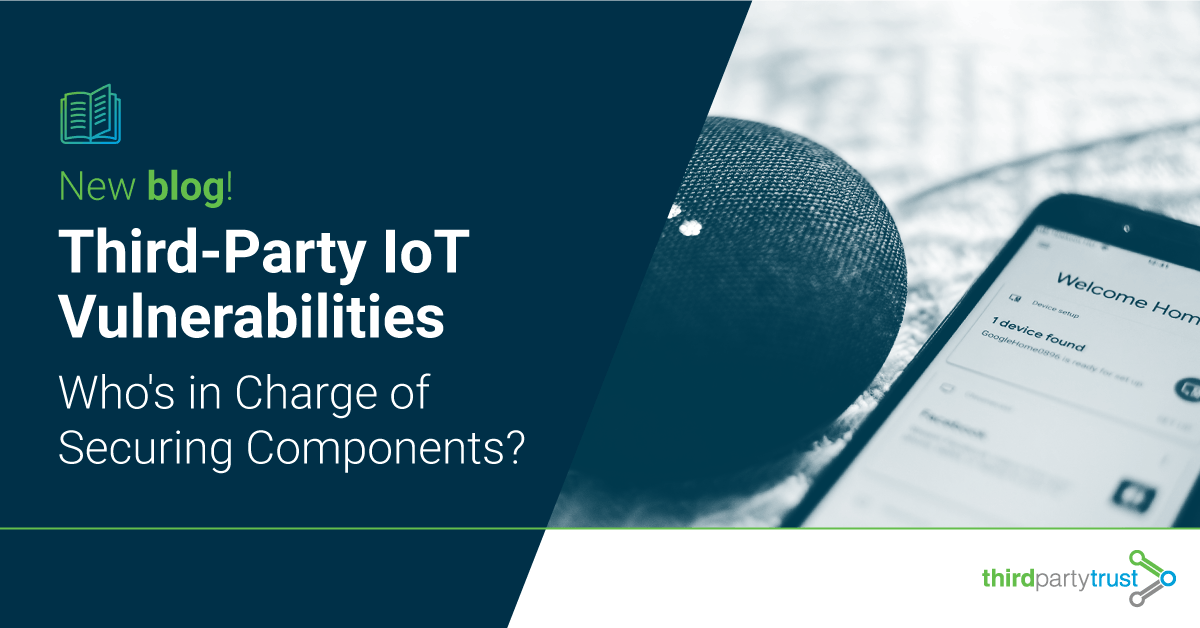Third-Party IoT Vulnerabilities: Who’s in Charge of Securing Components?
There are billions of Internet of Things devices in the world that perform critical functions and transform business processes, but they are also alarmingly vulnerable to risks that can lead to third-party IoT vulnerabilities. Here’s why: Manufacturers rely on third-party vendors that develop components with potential entry points for attackers.
Some might argue that the data breach liability corresponds directly to the third-party, but at the end of the day, the company whose customer information is stolen is the one who suffers the biggest impact. So who’s in charge of securing the components of IoT devices and minimizing this third-party risk?
The recent discovery of the Ripple20 vulnerabilities, affecting hundreds of millions of Internet of Things (IoT) devices, is the latest reminder of the dangers that third-party IoT vulnerabilities pose to connected devices. This set of vulnerabilities was threatening connected devices in nearly every sector – industrial controllers, power grids, medical, home, networking, transportation, enterprise, retail, defense, etc.
There has always been a push to shift liability to other parties in the value chain, especially when a vendor is involved. There’s also the issue of traceability. According to the researchers who found the Ripple20 vulnerabilities, which were set to be presented at the Black Hat information security conference:
“Over the past two decades this library has spread around the world by means of direct use as well as indirectly, through “second hand” use, rebranding, collaborations, acquisitions and repackaging, having been embedded and configured in a range of different ways. Many of the vendors indirectly selling and using this library were not aware of their using it”.
Don’t (only) blame it on the vendor
A recent study by the Ponemon Institute found that six out of ten organizations do not monitor the cyber-risks of IoT devices developed by third-parties, meaning they can eventually supply vulnerable products and be exposed to financial loss and reputational damage.
Security is usually an afterthought to new technology, but IoT devices are nothing new and will keep spreading throughout organizations and business processes — carrying healthcare data, payment information or access to the protocols of a smart home. Securing their components is a must amidst a huge promise to improve efficiency in decade old industries and provide insight for predictive analysis to help shape the way we interact with the world.
While it’s true that third-parties need to make a bigger effort to develop secure components, organizations that rely on them also need to be more aware of who they’re choosing to work with. Whether it be hardware, connectivity or additional services, they need to ensure their providers have the proper measures, assessments and checks in place.
But How?
Our ThirdPartyTrust platform allows organizations from any industry to streamline third-party risk management (TPRM) workflows. With the capability to customize vendor questionnaires, request industry standard questionnaires and certifications, it’s easy to include the relevant security checks in the overall assessment of an onboarding third-party. ThirdPartyTrust is a purpose-built TPRM tool that accelerates the third-party assessment/questionnaire review process through workflow automation and centralized communication.
For example, you might want to know which of your third-parties are using a certain component or protocol that is known to be vulnerable to cyber risk, and prioritize it according to your risk appetite. Is it something you can accept, or is it a deal breaker?
At a high level, there are several areas to address around IoT security:
- IoT Network Security: Protecting and securing the network connecting IoT devices to back-end systems on the internet.
- IoT Authentication: Providing the ability for users to authenticate an IoT device.
- IoT encryption: Encrypting data at rest and in transit between IoT edge devices and back-end systems using standard cryptographic algorithms.
- IoT PKI: Providing complete X.509 digital certificate and cryptographic key and life-cycle capabilities
- IoT security analytics: Collecting, aggregating, monitoring, and normalizing data from IoT devices and providing actionable reporting and alerting on specific activities or when activities fall outside established policies.
- IoT API security: Providing the ability to authenticate and authorize data movement between IoT devices, back-end systems, and applications using documented REST-based APIs.
Every enterprise, in some way or another, will be impacted by a connected device and having a framework to follow is, simply, a must.
To learn more about how ThirdPartyTrust can help you streamline your TPRM program, request your free trial now:




